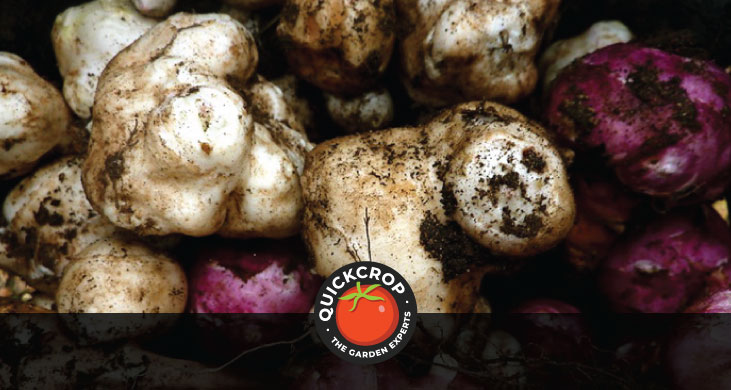How To Grow Artichokes (Jerusalem)

A comprehensive article on How to grow Artichokes (Jerusalem variety). Artichokes area very easy crop to grow but be careful as they are very hard to get rid of once established! Delicious roasted or even better pickled they are an interesting and unusual vegetable. There is a growing artichokes video at the bottom of this page for further information.
Where to Plant Jerusalem Artichokes
Before you plant your artichokes be aware that although they are a root crop they have very tall foliage which easily reaches 2 - 2.5 metres high. They will cast a large amount of shade so best planted at the North end of the garden. They can also be useful as a windbreak but will need to be supported with stakes and twine as they are prone to being blown over in Autumn gusts.
A word of warning!
Jerusalem artichokes can be very difficult to get rid of as they will grow new tubers next year from the tiniest bit of root left in the ground. Triple dig them when harvesting as you will always come across one or two you've missed!
Planting Jerusalem Artichokes
When planting your tubers it's a good idea to select the least lumpy ones you can. By planting the smoothest each year you will slowly breed out the knobbly ones which are more difficulty to peel. Fuseau is the most popular smooth variety but even they will benefit from careful selection when plantingJerusalem artichokes are very hardy plants so you should have no problems planting out as early as February.
Plant in loose, prepared soil about 15cm deep and 30cm apart in rows 90cm apart. Artichokes are not too fussy about situation and will grow in full sun or partial shade. They are also happy in most soil types unless very acid or waterlogged.
Don't worry which way up they are when planting, you'll find they will grow anyway.
Crop Care
Artichokes are unlikely to suffer from any pests or diseases, the only problem you might have is hares eating the stalks in Spring but this is easily solved by placing a cloche around the plants until they are established by the end of April.It's a good idea to 'earth up' artichokes once or twice in the growing season, do this when the plants are 30cm (1ft) high, you can continue every 2 weeks or so until the soil is 15cm (6in) around the stem.
Earthing up means dragging the surrounding soil up around the stem of the plant. This will make the plant sturdier in the wind and also increase the yield. If you have planted a row of artichokes you should end up with a ridge about 2 or 3 inches high around the plant.
In mid Summer pinch out the growing tips to restrict growth to 1.5-2m (5-6 1/2 foot) and concentrate energy on the tubers rather than new leaf growth, remove any flower buds which might develop.
If you are in a windy area you need to support the stems of your artichoke plants to prevent them blowing over and exposing the tubers; yields will also be lower if plants are damaged by Autumn gales. Hammer timber stakes into the ground at either end of the row and run a few lengths of wire or strong twine form one to the other to create support fence.
When leaves wither in late Autumn cut stems down to about 7.5cm (3 in) from the ground. You can lay the cut foliage on top of the soil fr protection and to make digging easier as you harvest.
Harvesting
Jerusalem artichokes can be harvested in late Autumn and dug right through the winter unless soil is prone to waterlogging. It is better to dig as you need them as they are thin skinned and dry out quickly but if you need to lift them they store well in boxes of moist sand.
Remember to use the knobbly ones for cooking while retaining the smoothest looking examples for planting next Spring. Jerusalem artichokes are knobbly and can be difficult to scrub so best boiled with the skins on and peeled afterwards. They can also be baked or stir fried and make an excellent soup. It might be worth mentioning that artichokes contain the carbohydrate 'Inulin' that is broken down by bacteria in the gut and can be responsible for wind in some people.
